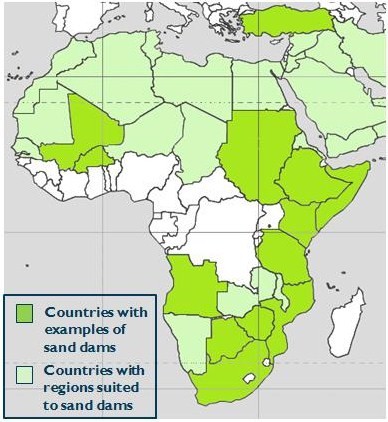User:Iangrahamneal/Sand dam page
Introduction
[edit]
Sand dams are a simple, low cost and low maintenance, replicable rainwater harvesting technology. They provide a clean, local water supply for domestic and farming use and are suited to semi-arid areas of the world.
The technology
[edit]
A sand dam is a reinforced concrete wall (or a similarly robust and impermeable weir) built 1-5 metres high across a seasonal sand river.
When it rains the dam captures soil laden water behind it – the sand in the water sinks to the bottom, whilst the silt remains suspended in the water.
Research on Kenyan dams shows that only 1 to 3% of rainwater is retained behind any individual dam, the remainder continues its natural flow towards the ocean. [1] Eventually the dams fill with sand - sometimes after only one rainfall or over 1 – 3 seasons. 25 to 40 % of the volume of the sand held is actually water.
A mature sand dam can store millions of litres of water – refilling after each rainfall providing a year round supply of clean water to over 1,000 people.
Application
[edit]
The highest concentration of sand dams with the strongest track record is found in Kenya although examples are found throughout world’s semi-arid regions from Angola to Zimbabwe. Further examples are recorded in Japan, India, Thailand, SW USA and Brazil
Sand dams can be built in the upper and middle courses of seasonal sandy river valleys (also known as wadis). Typically, sand dams are built in the transition zone between hills and plains where the gradient of the river bed is between 0.2 - 4 %, but in extreme cases sand storage dams have been constructed on slopes of 10-16% (Nilsson 1988). Dams must be built on bed rock or highly compacted sub-soil. For the obvious reason of economy on materials and labour, the stream must be reasonably narrow with well defined and stable river banks and the bedrock or impermeable subsoil within a few metres of the stream bed. Rocky banks and gorges are the most apt features. Further advice on the siting, design and construction of sand dams is available from the organisations and in the manuals listed below
How do people abstract the water from the dam?
[edit]
There are two simple ways:
1. Scooping a hole in the sand. The water will naturally emerge to the surface. Scope holes used for domestic water should be protected from contamination by livestock (by using acacia fencing or similar)
2. A slotted pipe buried in the sand that either passes through the dam wall or is connected to a simple hand pump situated on the river bank
Further advice on abstracting water from sand rivers is available from Water from sand Rivers, WEDC publications.
What are the benefits of a sand dam?
[edit]
File:Impact of sand dams 2.jpg
1. Low cost and maintenance
Sand dams are the lowest cost form of rainwater harvesting known – 3 to 100 times lower cost than other technologies. A sand dam is built to last over 50 years, has no operational costs and requires little maintenance.
2. Community owned and managed:
Most examples of sand dams are built by members of the communities they serve with support local and international development agencies. Community ownership and management is key to their successful operation.
3. They save time and enable increased food production and tree planting:
During drought periods in semi-arid regions, people might have to walk up to 12 hours a day to fetch water, which is often unsafe to drink. Freed from the chore of walking sometimes the whole day to collect the water, farmers are able to improve food production and generate surplus income.
4. They provide a clean, secure and local year-round water supply in water scarce environments:
The sand effectively acts as a large slow sand filter resulting high quality potable water. As the water is held under the sand, evaporation is minimal, people are protected from water-borne diseases and mosquitoes can’t breed – reducing the threat of malaria.
5. Wider benefits for health, education and communities:
In areas where sand dams have been built, communities have observed a dramatic fall in water related disease, an increase in school attendance and a significant increase in household income and food production.
6. They transform the local ecology
The water held in the sand behind the dam spreads horizontally creating a permanent increase in the water table, allowing trees grow naturally and transforming the local ecology. The dams create a natural buffer that reduces the threat posed by flooding and drought and builds the resilience of communities to cope with the impacts of climate change in semi-arid regions.
Organisations with significant experience building sand dams:
[edit]
• Excellent Development and Utooni Development Organisation (formerly Excellent Development Kenya)
• Acacia Institute and RAIN Foundation working through Sahelian Solution Foundation (SASOL)(Kenya)
• WaterAid working through Action Micro Barrage (Burkino Faso)
• Church World Service (Kenya)
• Dabane Trust (Zimbabwe)
• Mennonite Central Committee supporting sand dams in Kenya, Tanzania, Mozambique
• SOS Sahel supporting sand dams in Sudan and Kenya
• VSF Belgium (Kenya)
• World Vision (Kenya)
References
[edit]
(1) Hut R et al. 2008 Effects of sand storage dams on groundwater levels with examples from Kenya, Physics and Chemistry of the Earth Vol. 33, no. 1-2, 56–66
Bibliography
[edit]
• Sand dams: low-tech weapons against climate change, The New Scientist, 2006
• Two waterfalls do not hear each other, Ertsen et al. 2009
• [http://www.rainfoundation.org/fileadmin/PublicSite/Manuals/Measuring_and_modeling_hydrological_processes_of_sand-stirage_dams_on_different_spatial_scales.pdf Measuring and modeling hydrological processes of sand-storage dams on
different spatial scales, Quilis et al. 2008]
External links
[edit]
• Videos on sand dams
• Photos of sand dams
• RAIN foundation manual
• Sanddam.org
• Water from Sand rivers
• Water from Dry Riverbeds
• Artificial recharge (Chapter 6) - IRC
• VSF manual
- ^ Hut et al 2008







